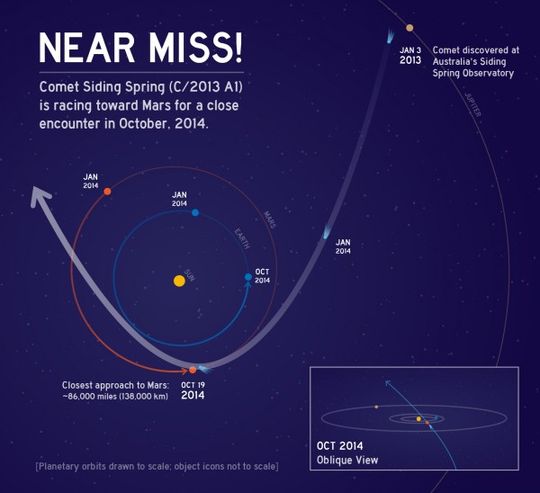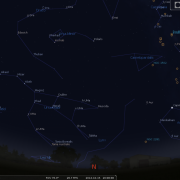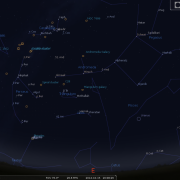In this month's Sky Notes:
- Planetary Skylights
- Comet C/2013A1 Siding Spring passes Mars
- Meteor Activity
- October 2014 Sky Charts
Planetary Skylights

 Mars and Saturn just about remain on view, very low in the WSW evening twilight sky, becoming increasingly difficult to spot if your horizon is cluttered. Saturn is lost by the end of the month, whilst Mars lingers, slowly sinking down toward the SW horizon.
Mars and Saturn just about remain on view, very low in the WSW evening twilight sky, becoming increasingly difficult to spot if your horizon is cluttered. Saturn is lost by the end of the month, whilst Mars lingers, slowly sinking down toward the SW horizon.
 Comet C/2013A1 Siding Spring, a binocular object, lies very close to Mars on the 19th (7:30pm). The moon lies nearby Mars on the 28th and Saturn on the 25th.
Comet C/2013A1 Siding Spring, a binocular object, lies very close to Mars on the 19th (7:30pm). The moon lies nearby Mars on the 28th and Saturn on the 25th.

 Uranus comes to opposition on the 7th and hence is due south at midnight. Neptune is visible in a telescope and lies near Sigma Aqr.
Uranus comes to opposition on the 7th and hence is due south at midnight. Neptune is visible in a telescope and lies near Sigma Aqr.
 Jupiter is a bright object in the dawn sky, moving into Leo by the month’s end. The moon is nearby on Oct 18th.
Jupiter is a bright object in the dawn sky, moving into Leo by the month’s end. The moon is nearby on Oct 18th.
 Mercury pops into the dawn sky during the final week of Oct and into November for its best morning apparition of the year. Look for it 30 minutes before sunrise (around 6am GMT) a few degrees above the east horizon.
Mercury pops into the dawn sky during the final week of Oct and into November for its best morning apparition of the year. Look for it 30 minutes before sunrise (around 6am GMT) a few degrees above the east horizon.
Comet C/2013A1 Siding Spring Passes Mars
Discovered in Jan 2013, comet Siding Spring is a comet from the Oort cloud, a giant swarm of debris chunks left over after the formation of the solar system which resides some 5000-100,000 AU from the Sun.
Containing up to 2 trillion chunks, this particular Oort fragment will pass exceptionally close to Mars on the 19th, skimming just 132,000 km above the red planet’s surface. At mag +8.3 the comet should be an easy binocular target, though will be better seen in a short focal length scope just a few arc minutes from Mars.
As astronomical twilight exists by 19:45h look from 19:30h. Viewing will be a bit of a challenge as Mars will only be five degrees above the SW horizon.

Meteor Activity

There are no less than three meteory showers to tempt you outside on October nights:
- The Orionids (Oct 16- 27) are the months most reliable shower, peaking on the 21st with hourly rates approaching 25. Like May’s Eta Aquarids, Orionids are associated with Comet Halley, but are more favourable for northern hemisphere observers due to the radiant being situated high in the S by early morning hours. Orionids are swift, often producing persistent trains. With the moon just a couple of days off New, this year offers an excellent opportunity to catch some shooting stars - especially in the early dawn sky.
- The weak Piscid shower has three peak dates, Oct 13th being the optimum one. Observed rates are little better than sporadic levels - around 3-7 per hour. Piscid meteors are often slow, of long duration, but not very brilliant.
- Perhaps the most interesting shower is the Giacobinids or Draconids (Oct 6 -10th peaking on the 8th) which are associated with the periodic comet Giacabini- Zinner (6yrs) The shower is very erratic, but can produce outbursts of activity so keep an eye open, particularly on the 6th. Early morning viewing will be the optimum time.
September 2014 Sky Charts
Click each image to see a full-size Sky Chart:
 |
 |
| Looking South Mid October-20:00h |
Looking North |
 |
 |
| Looking East Mid October-20:00h |
Looking West Mid October-19:45h |
Image Credits:
- Planets and Comet Chart: NASA
- Sky Charts: Stellarium Software
- Log in to post comments




